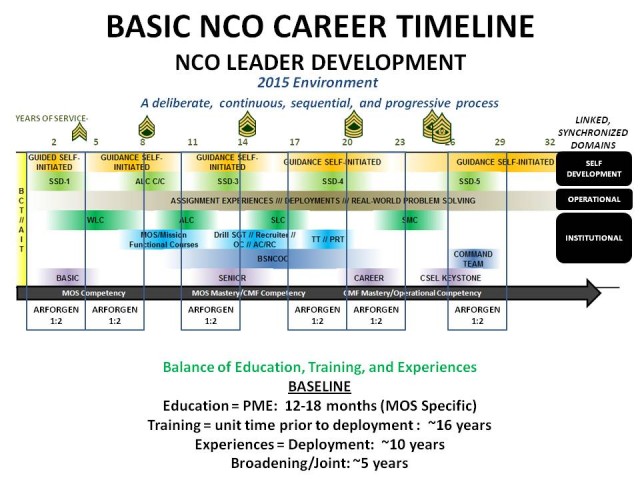WASHINGTON (Army News Service, April 13, 2011) -- Ask business professionals and they will likely tell you, having the right talent, at the right time, in the right quantity and at the right location is vital to victory in the marketplace.
The same holds true for the Army as it establishes the Command Sergeant Major/ Sergeant Major Professional Development Proficiency Codes to better identify and develop its top enlisted talent for success in the 21st-Century operational environment, said Gerald Purcell, a personnel policy integrator for the Department of the Army Office of the Deputy Chief of Staff, G-1.
The Army is pushing forward with processes to identify high performers and provide them with additional opportunities for assignments that prepare them for senior leadership positions all the way up to the national stage.
"The establishment of new Professional Development Proficiency Codes will serve as a tool for HR managers to effectively develop our senior-most noncommissioned officers from an assignments/experiences perspective across various levels of responsibility within a single pay grade," Purcell said. "This new approach enables a more direct, cognizant capacity behind making assignment decisions with the intent of fostering leader development."
Fostering leader development is the primary goal of the Army Leader Development Strategy, which defines the characteristics desired in Army leaders as they progress through their careers. It establishes eight imperatives which are:
-- Encourage an equal commitment by the institution, by leaders and by individual members of the profession to life-long learning and development.
-- Balance commitment to the Training, Education, and Experience pillars of development.
-- Prepare leaders for hybrid threats and full-spectrum operations through outcomes-based training and education.
-- Achieve balance and predictability in personnel policies and professional military education in support of Army Force Generation.
-- Manage the Army's military and civilian talent to benefit both the institution and the individual.
-- Prepare leaders by replicating the complexity of the operational environment in the classroom and at home station.
-- Produce leaders who are mentors and who are committed to developing their subordinates.
-- Prepare select leaders for responsibility at the national level.
Details about significant changes were outlined in a memorandum for worldwide distribution issued Oct. 21, 2010. It included the establishment of new codes for additional skill identifiers, or ASIs, and the new expert "skill level 6."
Some of the more than 75 revisions include the establishment of "ASI 8C" (general- officer level command sergeant major), "ASI 8S" (senior-level sergeant-major experience) and "ASI 7C" (brigade-level command sergeant major), "ASI 7S" (primary-level sergeant major), "ASI 6C" (battalion-level command sergeant major) and "ASI 6S" (initial-level sergeant major). The codes will tell human resource managers what level of experience the senior noncommissioned officers have and as a result, will make future assignment decisions highly effective, Purcell said.
Human resource managers were authorized to begin personnel classification changes as early as April 1, 2011.
The Army G-1 worked in concert with each proponent to identify and group all E-9 positions into three distinct groups beginning with entry-level-type sergeant-major positions. Next, these senior noncommissioned officers will be eligible to compete for selection as battalion command sergeants major.
The intent is to make follow-on assignments at primary-level, mid-level E-9 positions or brigade command sergeant major/sergeant major positions. Moving up, eligible Soldiers will then be able to fill the most senior-level sergeant major, general-officer-level command sergeant major positions as fully-developed expert noncommissioned officers, said Purcell.
These changes are intended to support the creation of a new Basic NCO Career Timeline by fiscal year 2015, which supports the principles of the Army Leader Development Strategy and aligns with Army Force Generation manning requirements, he said.
"The development of this typical NCO career timeline reaffirms our commitment to leader development by creating conditions that support a balance between training, education and experience to develop our force while encouraging life-long learning," Purcell said.
Related Links:
Army Leader Development Strategy
SMA says retention-control points to shape force
Department of the Army Office of the Deputy Chief of Staff, G-1


Social Sharing